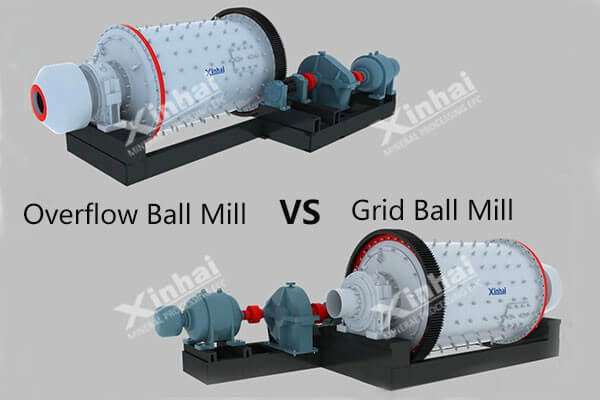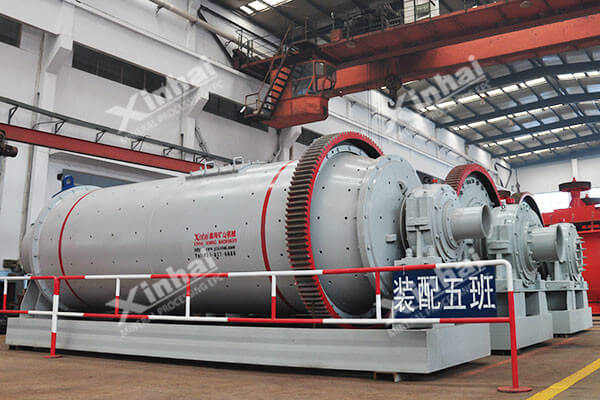

Warm Tip: If you want to know more details about equipment, solutions, etc, please click the button below for free consultation, or leave your requirements!

In this post, we will talk about overflow ball mill VS grid ball mill in 7 aspects.
Usage
Structure
Working principle
Discharged way
Discharged particle size
Production capacity
Subsequent maintenance
Ball mill is widely used in cement, ceramics, glass, mineral processing, building materials, and other industries. And according to the ore discharge way, ball mill can be divided into overflow ball mill and grid ball mill.
If you are looking for the most suitable ball mill for your grinding work, you're in the right place. Let's drive right in.
In general, ball mills are used for grinding operation for crushed material.
As many grinding tests proves, when the feeding particle size is 5-25 mm, it's better to use wet ball mill, and the discharging particle size of wet ball mill is normally 0.075-0.4 mm; while the discharge particle size of the dry ball mill can reach as fine as 0.038 mm.
These two types of ball mills basically consist of five parts: feeding device, supporting device, rotating part, unloading device and transmission. The main components are cylinder, lining plate and compartment board.
The difference between overflow ball mill and grid ball mill lies in the structure of their unloading device:
Grid ball mill has a grid plate at the discharge end on which there are several fan-shaped orifice plates. And the width of the grate holes on the orifice plate is 7 mm -- 20 mm.
The ground ore passes through the grid plate along with the pulp. The grid plate near the side of the discharge end is equipped with an ore lifting device, which is a radial rib. The ribs divide the grid plate and the end cap into several fan-shaped chambers leading to the hollow journal.
When the grid ball mill rotates, the radial ridges play a role in lifting the pulp. To be specific, the slurry discharged from the holes in the grid plate is lifted up to the hollow shaft neck of the ore discharge, and then discharged from the mill through the hollow shaft neck.
Overflow ball mill does not have grid plate to accelerate ore discharge.
Due to the fact that the hollow axle diameter at the discharging end is slightly larger than that at the feeding end, the slurry in the grinding machine has a certain inclination towards the discharging end. Therefore, only when the slurry surface in the cylinder is higher than the lowest generatrix level of the inner diameter of the discharge pipe, the ground material can be discharged from the discharge pipe.
On the other hand, the inner surface of the hollow journal bush in an overflow ball mills is provided with a reverse spiral blade, which can return the grinding balls and coarse ore in the slurry to the overflow ball mill.
The material is fed from the feeding port of the cylinder body, and the ore material and grinding medium (steel ball) inside the cylinder body continuously collide and move forward with the rotation of the cylinder body. Under the action of extrusion, impact force and grinding and stripping force, the material can be ground and moved towards the outlet. Due to the continuous forced feeding of the material, the material is slowly approached to the outlet under the action of pressure, and the material which finally reaches the finished particle size is discharged at the outlet. When in wet grinding, the material is discharged in the form of slurry, while in dry grinding, the material is discharged mixed in the air stream.
In the case of continuous loading and unloading, the material in the grid ball mill is forced to discharge through the grid plate under the pressure, which is called the active ore discharge.
Whi the material in the overflow ball mill overflows from the discharge pipe when the slurry level in the barrel reaches a certain height, usually called passive ore discharge.

Because of the active ore discharge of grid ball mill, the materials stay relatively shorter in in the cylinder body. Therefore, the particle size is relatively coarse (generally 0.2-0.3 mm), which is suitable for the primary grinding stage.
While because of the passive ore discharge of overflow ball mill, the materials stay relatively longer in the cylinder body. Therefore, the phenomenon of over-grinding is easy to occur, and the particle size of its discharge is relatively fine (generally less than 0.2 mm), which is suitable for fine-grained grinding and is commonly used in the stage of concentrate re-grinding.
Because of the different methods of ore discharge, different types of ball mills have different production capacities.
Grid ball mill is forced to discharge and the grinding time is short. So more materials can be processed in a certain period of time, and the production capacity is larger. Overflow ball mills are just the opposite.
In comparison, the overflow ball mill has a simple structure, and there is no grid plate at the discharge end, which is convenient for maintenance. However, the grille central vent, grate gap and the gap between compartments are easily blocked by slurry at the ore discharge end of the grid ball mill, which increases the difficulty of maintenance work.
Above we have made a detailed introduction on the usage, structure, working principle and effect of overflow ball mill and grid ball mill. According to the experience of technicians who have worked for many years in Xinhai mining company, multiple basic parameters needs to be considered when selecting proper ball mill, including processing capacity, input grain size, grinding fineness and configuration of the matched classifying equipment, etc.
Last: 3 Factors Affect Froth Flotation Process?
Next: 5 Comparisons Teach You How to Choose Spiral Classifier or Hydrocyclone?
110 Ways to Improve the Grinding Efficiency of Your Ball Mill
 5
5
 5467
5467
2Causes and Solutions of Ball Mill Noise
 0
0
 3433
3433
3What Factors Will Influence Ball Mill Grinding Efficiency?
 0
0
 4754
4754


What Are the Differences Between CIP and CIL?
 11097
11097
 0
0